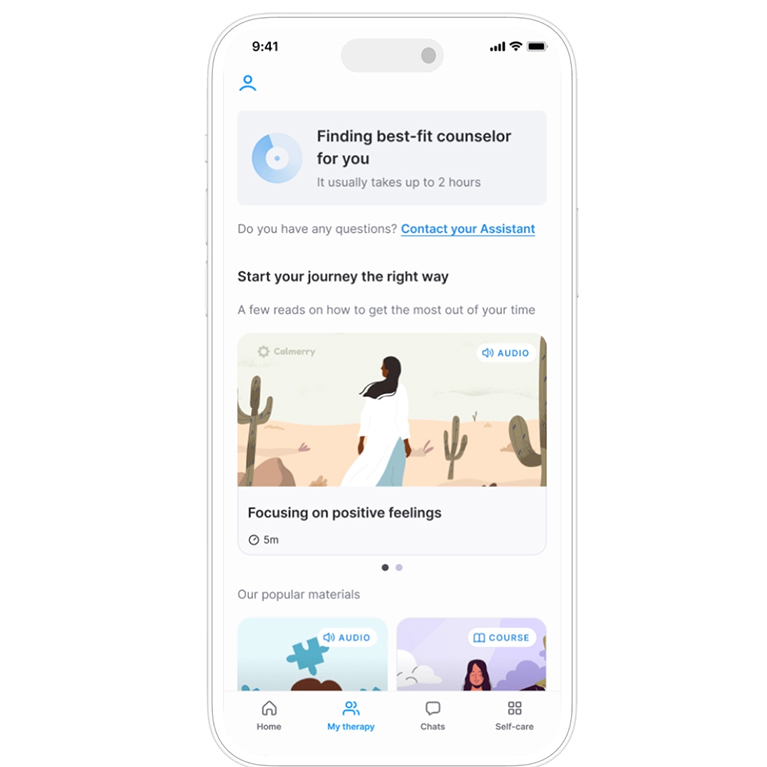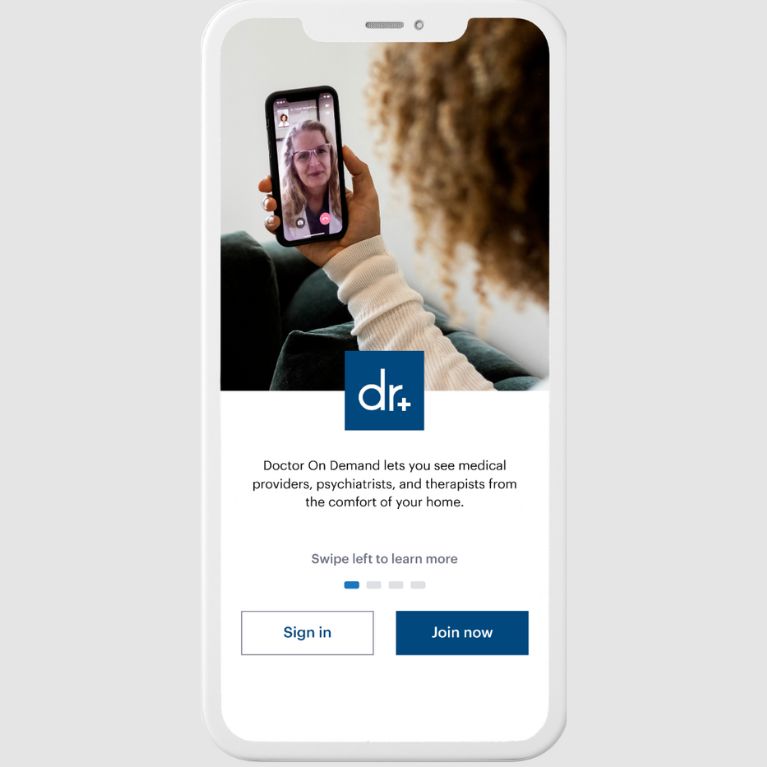Research has shown a significant spike in mental health conditions like anxiety, depression, and insomnia since the COVID-19 pandemic. (1) Unfortunately, as the need for care increases, individuals seeking therapy and psychiatry services are experiencing longer wait times. (2) Online mental health platforms have become a popular solution, often with expansive provider networks, flexible appointment times, and the convenience and ease of receiving care from anywhere.
Even so, cost remains another significant barrier to mental health care. (3) While insurance coverage is expanding for these services, finding a provider that accepts your plan can be difficult due to low reimbursement rates for therapists and psychiatrists. Therapist Rychel Johnson says, “The process of finding a mental health provider is often daunting enough to prevent someone from seeking out a therapist in the first place.”
Grow Therapy aims to address this issue by partnering with over 50 insurance companies to help make care more accessible. This online therapy platform is a hub for private practicing mental health providers, offering virtual and in-person therapy and psychiatry with insurance or self-pay options.
We researched and tested the Grow Therapy user experience to provide you with everything you need to know about how it works, how much it costs, and how it compares to other teletherapy services. Read our full review below to learn more and help you decide if it’s right for you.


Key product features
What you should know
Grow Therapy has a network of over 15,000 mental health providers who can provide talk therapy and psychiatry. You can select your provider based on the type of care, specialties, therapy methods, and other personal preferences.
- Creating an account and scheduling appointments on the website is quick, easy, and free.
- Pricing on Grow Therapy varies significantly depending on your insurance benefits or the provider-set pricing for out-of-pocket costs.
- If you prefer in-person therapy, you can filter by therapists who offer that treatment option.
- Providers can care for a wide age range, including some who care for children as young as six years old.
What is Grow Therapy?
Grow Therapy offers talk therapy and psychiatry services through a vast network of licensed providers. It matches users with clinicians who are licensed to practice within their state of residence. Individuals can narrow their search further based on the provider’s specialties and any personal preferences, including treatment method, gender, age, and identity. When booking sessions, you can also choose between virtual or in-person appointments.
Grow Therapy’s licensed therapists focus on helping you manage your condition and improve your overall mental health through various talk therapy methods, such as cognitive behavioral therapy (CBT), interpersonal therapy, and mindfulness. Psychiatrists who practice through the network can provide a full mental health evaluation, diagnose conditions, and prescribe medications.
Creating a Grow Therapy account is free, and you’re billed per session. The platform is in-network with over 50 insurance plans, with the average co-pay ranging from $0 to $30. You can also self-pay for therapy and psychiatry appointments, which can cost as little as $70 and up to $300, depending on the service, provider, and location.
The platform uses an online dashboard where you can schedule appointments and securely message providers. Grow Therapy’s website also offers a resource hub with educational articles on various mental health topics and self-help tools.
What our experts say
“Having a one-stop shop for diagnosis, therapy, and psychiatry is beneficial for the typical mental health client living a busy life and needing help managing symptoms,” says Johnson. “The Grow Therapy website also has resources and articles to help people determine if the platform is appropriate for their mental health needs. However, consumers may feel overwhelmed due to differences in financial obligations that vary state to state.”
What customers are saying
Grow Therapy has impressive customer reviews on Trustpilot. With nearly 4,000 reviews, it earns an overall 4.7- out of 5-star rating. Many reviewers cite how comfortable they feel with their providers, who offer caring and compassionate care. Others highlight how easy the platform is to use.
In their Trustpilot review, LaKeshia P. writes:
“Grow Therapy provided me with an awesome, open-minded, relatable therapist. I can easily open up to her, and I feel she really listens to me and provides amazing feedback.”
LaKeshia P., Trustpilot
“It’s very easy to set up appointments and connect with care immediately,” says Cameron E. “Insurance was easy to attach to my profile, and it was fairly painless to look through therapists in my state who specialize in the things I need help with and the way I would like to go about solving those struggles.”
As another testament to the platform, we found many providers who describe how much they enjoy working for the organization. For example, Erika is a provider through Grow Therapy who says, “I absolutely love using the platform! It’s incredibly user-friendly and easy to navigate. The admin staff at Grow Therapy are simply amazing—they’re always so helpful and patient, and they really took the time to guide me through everything during onboarding. I also value being part of the Grow Therapy community and connecting with other providers. It’s been a fantastic experience!”
Unfortunately, the billing process became a headache for a few reviewers. Some say Grow Therapy’s quote before booking an appointment wasn’t accurate, and they were billed a different amount. When using insurance, we always recommend contacting your plan directly to ensure you know the exact costs before using any service.
Trustpilot reviewer Rachael commented, “I was given a quote for $0 to $50 per appointment, and then was charged $180 for an appointment that I was 10 minutes into, and the connection was lost. It is almost impossible to get ahold of anyone there to ask questions or get help. They just tell you to ‘check your portal.’ In the less than 10 minutes I got with a provider, he was late to the appointment and looked like he just rolled out of bed.”
Specs
| Cost | Varies by insurance and provider |
| Insurance accepted | Yes |
| Therapist assignment | You choose |
| Session type | Virtual, in-person |
| Platform | Online |
| Ages | Varies by provider |
Our Grow Therapy experience
I set out to test every aspect of the Grow Therapy platform to help you understand what to expect if you use its services. When I started exploring the website, I was impressed with how straightforward it was to navigate. I appreciated that users could explore all provider and treatment options without being required to sign up for an account or provide any personal or billing information. You can begin a search for a provider based on your state, insurance provider (or cash pay), and your unique mental health needs.
Grow Therapy claims to have thousands of providers within its network, so I was curious to see how many options I’d have within my home state of Wisconsin. When I filtered by talk therapy providers who are in-network with my United Healthcare/Optum plan, 38 matches were found. It was slightly higher at 40 providers when I changed my payment option to cash pay. My search was significantly narrowed when I switched to medication management, with only three psychiatrists available within the state, regardless of whether I was paying through insurance or out-of-pocket.
For both talk therapy and psychiatry providers, I could review each professional’s profile before choosing who to work with. The profiles seemed warm and welcoming, and each one included many details, including the provider’s credentials, experience, specialties, therapy approach, and availability.
When it came time to schedule an appointment, the providers offered solid availability. Most had timeslots within 24 to 48 hours. Many also offered weekend, evening, and early morning sessions, which can help provide good flexibility for those with busy daytime schedules. I appreciated that I could also see their extended calendars to help me know which providers’ schedules would fit my needs long-term.
When I scheduled an appointment using my insurance, Grow Therapy estimated my cost between $5 and $50 for talk therapy and $10 to $69 for psychiatry. I felt a bit uneasy, not knowing the exact price. Those ranges are pretty wide and can make a big difference in overall cost after attending several sessions. I had to call my insurance to verify my session cost because I didn’t want to risk finding out when I received my bill.
I also explored the cash pay options to compare the cost difference. When searching for talk therapy, I found sessions cost as little as $70 and up to $250 for an initial 60-minute appointment. As expected, psychiatry appointments cost more, with sessions ranging from $100 to $350.
Before booking a session, I created a Grow Therapy account. The process was incredibly quick and easy: all I had to do was enter my email address, choose a password, and verify my account via email. The patient portal offers a basic, user-friendly design, allowing you to see upcoming appointments easily, book new sessions, message providers, and perform provider-assigned tasks.
How we test online therapy
Our reviewers thoroughly test and evaluate each telehealth service we recommend. Each review also benefits from the expertise of mental health experts, experienced fact-checkers, and evidence-based research. To learn more, read our full teletherapy testing methodology.
Therapist quality—30%
A telehealth service must have qualified providers who can balance professionalism while building a trusting relationship with each user. The therapists should be certified, experienced, and knowledgeable. Here’s what we look for:
- Expertise
- Personalization
- Interaction quality
Accessibility and convenience—30%
Teletherapy can be an excellent solution for many individuals who find it challenging to engage with mental health care. Many individuals struggle to overcome various barriers to care, whether it’s lack of accessibility, high costs, or not enough time. Teletherapy can offer enhanced convenience to help more people get the care they need. We evaluate:
- Ease of use
- Availability
- Platform reliability
Cost and value—20%
Mental health care is a necessity for many individuals, yet cost remains a significant barrier (10). It becomes even more difficult for those without insurance that covers it. That’s why assessing the cost-effectiveness of each service is essential.
Here’s what we factor into a teletherapy’s cost and value rating:
- Pricing transparency
- Insurance and coverage
- Value for money
Support and resources—10%
Quality mental health care goes beyond your direct communication with your provider. You must constantly practice the techniques and coping mechanisms we learn. Additional support and resources can help individuals learn more about their mental health and expand on their therapeutic work between sessions.
Our factors in this rating include:
- Supplementary materials
- Customer support
- Aftercare
Privacy and security—10%
The convenience of teletherapy also comes with some risks. Teletherapy providers must prioritize privacy and data protection as clients provide personal and vulnerable information. Clients should be able to trust the platform to handle their personal data responsibly, with strong security measures in place.
Here’s what we’re looking for:
- Compliance with HIPAA and data protection laws
- Encryption and security measures
- Anonymity options
Here’s what we’re looking for:
- Compliance with HIPAA and data protection laws
- Encryption and security measures
- Anonymity options
Compare Grow Therapy

|

|

|

|

|
|
| Grow Therapy | Brightside | Calmerry | BetterHelp | Doctor on Demand | |
| Rating | |||||
| Cost | Varies by insurance | $95-$349 monthly | $57-$90 weekly | $280-$400 monthly | $129-$299 per session |
| Therapy type | Individual, couples, teen, and child therapy | Individual therapy | Individual and couples therapy | Individual therapy | Individual and couples therapy |
| Insurance accepted | Yes | Yes | No | No | Yes |
| Prescriptions available | Yes | Yes | No | No | Yes |
| Ages treated | Varies by provider | 18+ years old | 18+ years old | 18+ years old | 18+ years old |
How does Grow Therapy work?
Finding care
To get started with Grow Therapy, you can either create an account first or begin browsing services and providers immediately. If you choose to register, the process is free and quick. You’ll enter your email address and choose a password. Then, Grow Therapy sends you an email with a link to verify your account. Once you’ve completed that step, you can sign in to your account and schedule your first appointment.
If you want to see your provider and session options before signing up, you can start browsing the network of clinicians without registering for an account. You’ll enter your location, insurance provider, and mental health needs to pull an initial list of licensed providers. You can filter your list further by session type, therapy methods, gender, age, identity, language, or availability. Because Grow Therapy offers virtual and in-person care, you can also sort your provider list by which type of care you prefer.
You can view each provider’s in-depth profile from your personalized list to learn more about their experience, specialties, treatment approaches, and more.
Scheduling sessions
When you find your ideal therapist and appointment time, click “Book session” to create an appointment. You’ll enter your name, date of birth, insurance information (or choose self-pay), address, and billing information.
Your first session with a provider may last between 30 and 60 minutes, depending on the provider and whether you’ve selected talk therapy or medication management. The length of your follow-up sessions can also vary, so we encourage discussing this with your therapist or psychiatrist during your first visit.
Attending appointments
After booking your session, you’ll receive a confirmation email with instructions for attending. For in-person sessions, you’ll go to the clinic location listed. If you selected a virtual appointment, the email will include the meeting link to join online. You can also log into your patient portal online to access your appointment link anytime. Sessions are conducted through video conferencing, so you must grant Grow Therapy access to your device’s camera and microphone.
Medication management
If you’re engaging in psychiatry appointments, your provider may prescribe medication as part of your treatment plan to help manage your mental health symptoms. If so, they’ll send the prescription to your pharmacy of choice.
Follow-up care
Between sessions, your provider may enable communication via email, phone, or secure messaging through your patient portal. Remember that providers act as independent contractors, so you should discuss communication expectations with them directly to help you understand how often you can contact them and when you can expect responses.
Users can book follow-up appointments through the online dashboard at a cadence agreed upon between them and their provider. You can switch providers at any without having to request a change or wait to be rematched; simply schedule an appointment with a different therapist or psychiatrist.
Who is Grow Therapy right for?
Grow Therapy’s versatility makes it an excellent platform for many individuals seeking mental health care. If you want the freedom to choose your own therapist, the extensive provider network available through the platform provides plenty of choices. Depending on your location, you can browse up to hundreds of options to find one you feel the strongest connection with.
Finding a provider who’s in-network with your insurance plan can also feel incredibly challenging. Many private practice mental health professionals don’t accept insurance because of coverage limits, difficulties entering networks, and administrative burdens. (4) Grow Therapy helps providers connect with multiple insurance networks and takes care of the administrative work for them, allowing them to focus on patient care. This helps broaden the provider base for patients who want to reduce costs by using their benefits to pay for care.
Grow Therapy offers in-person appointment availability for those unsure about virtual mental health care. You can choose all in-person sessions, start with in-person sessions until you feel confident enough to switch to video calls, or alternate between the two, depending on what works best for you and your schedule for each session.
The virtual session availability can be beneficial for individuals with busy schedules or those who experience difficulties accessing care due to physical limitations, living remotely, or lack of provider availability. Video conferencing allows you to join from anywhere at any time. Moreover, providers can offer more availability to help meet the needs of those who want morning, evening, or weekend sessions.
Grow Therapy can be an excellent option for online therapy for kids. Some therapists and psychiatrists can treat children as young as six years old. The platform allows multiple people to join live sessions, so parents and caregivers can attend sessions if appropriate.
Who should seek an alternative to Grow Therapy?
Grow Therapy isn’t the most appropriate option for some individuals. Teletherapy can have incredible benefits, but it may feel overwhelming to less tech-savvy individuals. If you struggle with technology, registering and scheduling online and attending virtual sessions may feel challenging.
While Grow Therapy offers self-pay options, it’s geared more towards individuals paying through insurance. The costs per session can add up quickly if you pay out-of-pocket. You can find more affordable online therapy options that focus on reducing costs for those who are uninsured or underinsured.
The platform also doesn’t recommend its services for those experiencing a mental health emergency or crisis. Instead, you should get immediate help by calling 911, texting HOME to 741-741, or visiting a local emergency room.
Can Grow Therapy prescribe medication?
Some providers on Grow Therapy can prescribe medication. When booking an appointment, you can filter by talk therapy or medication management. Choosing the latter will connect you with a curated list of providers licensed to prescribe medication in your state. The types of medications prescribed will vary by provider.
Can I receive a mental health diagnosis through Grow Therapy?
You can receive a mental health diagnosis through Grow Therapy, but it depends on your provider’s credentials and state requirements. Those who are licensed in psychiatry can diagnose conditions and prescribe medications. On the other hand, many providers who engage in talk therapy focus more on helping you manage your symptoms and improve daily life by working to identify and change troublesome thoughts and behavior patterns. (5, 6)
Grow Therapy subscription plans
Grow Therapy doesn’t offer any subscription plans. Instead, you pay per session for your therapy appointments. You can book at the cadence that works best for you without worrying about following any subscription limitations or wasting money if you aren’t using it frequently enough.
Grow Therapy pricing
Grow Therapy bills per session, but the cost can vary greatly depending on your location, how you’re paying, and which provider you schedule with. The platform is in-network with over 50 insurance plans, including major providers like United Healthcare, Aetna, Cigna, Anthem, and Humana. Those using insurance could pay as low as $0 to $20 per session, but it could be higher than that, depending on your coverage. We recommend contacting your plan directly to clarify your costs and eligibility before scheduling.
The platform doesn’t limit its services only to those with insurance. You can also book appointments using the self-pay option. In these cases, the pricing is upfront—you’ll know exactly what you owe before booking. However, the cost ranges widely depending on your location and the provider you choose. In my state, I found talk therapy appointments for between $70 and $250 and psychiatry sessions for $100 to $350.
Because providers operate as independent clinicians, they may also choose to offer a sliding fee scale for uninsured individuals to help make services more accessible. Ultimately, the therapist or psychiatrist determines the final cost, so we recommend discussing it with them before or during your session.
How therapists are onboarded
Grow Therapy contracts with private-practice mental health providers. New providers interested in joining the network must undergo a meticulous credentialing process to ensure they meet specific standards and qualifications. A credentialing committee reviews all submissions to determine who meets the requirements, similar to running a background check.
To start this process, interested providers must submit a quick form with their name, contact information, and the state in which they’re licensed to practice. Then, a member of the Grow Therapy onboarding team contacts them to discuss whether it’s a good fit. Next, the provider must submit a credentialing form, which includes their licensing information, NPI number, resume, and DEA registration (if applicable). Once the credentialing team verifies the information and ensures the provider is in the network with at least one insurance plan, the provider can create an account through Grow Therapy and begin seeing patients.
Providers are responsible for re-credentialing when necessary. Moreover, the Grow Therapy team conducts ongoing monitoring to ensure all therapists and psychiatrists meet high patient care standards.
How many therapists are on the platform?
Grow Therapy states that it has over 15,000 active providers on its platform. However, the number of providers available to you will depend on where you live and the type of care you need. Therapists make up the majority of the provider network, with significantly fewer psychiatrists available in many locations.
Onboarding new users
Creating a user account is free and only takes a minute. Grow Therapy asks for your email address and a password. Then, you’ll receive an email to verify your account. After that, you can log into your dashboard and begin scheduling appointments.
You can schedule an appointment before creating an account; Grow Therapy will create your account through the scheduling process. When booking an appointment with a provider, you must provide your name, date of birth, insurance information (if applicable), and address.
How are new users matched with a therapist?
Grow Therapy gives new users a list of providers licensed to practice in the user’s state of residence. Users can choose to narrow the list through various filters, such as in-network providers, specialties, therapy methods, age, gender, and more. While reviewing the list, you can view detailed profiles for each provider to help you try to find the best fit. If you meet with a therapist and decide it isn’t a good match, you can schedule with a new provider anytime.
Grow Therapy vs. Headway
Grow Therapy and Headway share a similar mission of making mental health care more accessible for those in need. Both focus on connecting providers with patients seeking to pay for therapy through insurance benefits. Like Grow Therapy, Headway also offers talk therapy and medication management options in person or virtually, depending on the provider’s availability.
With over 27,000 licensed professionals, the Headway provider network is slightly larger than Grow Therapy’s 15,000. They act as independent contractors who undergo a similar credentialing process before joining the platform to ensure they have the necessary qualifications and can provide high-quality care.
Another similarity between the two platforms is the number of in-network insurance plans. While Grow Therapy works with over 50 plans, Headway accepts over 45.
The number of in-network providers within those plans can vary. For example, I couldn’t find any therapists or psychiatrists when I searched for care within Wisconsin using my UnitedHealthcare insurance. However, when I switched to Cigna, Aetna, or Anthem, I was presented with over 200 available providers for each plan. Unfortunately, Headway doesn’t offer a self-pay option. If your insurance isn’t accepted, you’ll have to seek care elsewhere.
Through Headway, each provider also chooses its own platform to host virtual sessions. When confirming your appointment, they send you instructions on how to join your sessions. This is different from Grow Therapy, where all sessions are hosted through the same videoconferencing platform.
One of Headway’s advantages is who can get treatment. Some providers treat children as young as one year old. In comparison, Grow Therapy treats children ages six and up.
Overall, the experience feels very similar between the platforms. Both connect you with an extensive nationwide network of therapists and psychiatrists verified as in-network with one or more insurance plans.
Grow Therapy vs. BetterHelp
BetterHelp has a considerably different operating model than Grow Therapy. Both connect users with a network of mental health providers, but the similarities end there. While Grow Therapy offers mental health diagnosis, therapy, and medication management, BetterHelp providers only offer talk therapy.
BetterHelp’s therapy services are open to individuals, couples, and teens. One significant benefit is that the platform offers more flexibility in how patients engage with their therapist. They can choose to communicate through video sessions, phone calls, live chats, and asynchronous messaging. Users also have access to helpful tools between therapy sessions, including worksheets and free group sessions.
When signing up for BetterHelp, you complete a detailed questionnaire about yourself, your preferences, and your mental health symptoms. The platform uses AI to match you with the best provider for your therapy needs. You don’t get to choose your provider like you do with Grow Therapy. However, you can request a new therapist at any time if you aren’t connecting well.
BetterHelp also doesn’t accept payment through insurance. Instead, it uses a subscription plan model that costs between $70 and $100 out-of-pocket weekly, depending on your location, provider availability, and therapy preferences. The subscription can be more expensive overall, but you get a lot out of it, including weekly live therapy sessions, unlimited provider messaging, and the extra tools mentioned above.
How to choose the therapy platform for you
Before choosing a mental health platform, you should consider various factors that can impact your overall experience.
Services offered
First and foremost, you want to ensure the platforms you’re considering offer the type of care you need. Some platforms specialize in talk therapy, while others focus on medication management. Because some conditions benefit most from combining both treatment options, you may be best served by a platform that can offer it all in one place. (7) Understanding which services each teletherapy platform offers can help narrow your choices.
Provider quality
Part of our meticulous review process includes researching how each platform recruits and vets its providers to ensure they can provide high-quality care to patients. This should also be an integral part of your decision-making. You should review each clinician’s credentials and experience. We also recommend exploring their approach to care to ensure it meets your needs and aligns with your therapy goals.
If you can, try to meet with the provider before your first appointment for a short consultation or begin your first session with a conversation about their qualifications. You can also learn a lot about mental health professionals by reviewing user reviews to hear the firsthand experiences others have had. If you feel like you can trust your provider to care for you well, it can help foster a deeper connection and enhance your therapy experience. (8)
Medication management
Medication can be an integral part of a mental health treatment plan for many individuals. (9) If you’re already taking medication or feel you could benefit from it, you’ll want to ensure the platform you choose has providers licensed to prescribe in your state. The type of medication you need is another vital consideration. Many online mental health platforms can’t prescribe controlled substances, which may be used to treat some conditions, like ADHD, anxiety, or depression. Understanding which medications each service prescribes can help ensure you don’t waste time or money on a platform that can’t fill your prescription.
Scheduling
Finding time to take care of mental health can be a huge barrier. (10) Life can be busy, and fitting appointments into your day can feel challenging. Consider whether you need early morning, lunchtime, evening, or weekend sessions. Before choosing a platform, we also recommend looking beyond the first appointment and browsing the provider’s full calendar to help you understand if they will continue to be available at the times you need long-term.
Cost
Finding high-quality care is one piece of the puzzle. It also must fit within your budget so you can continue to access care without adding financial stress. If you plan to use insurance, you should contact your benefits provider directly to help you understand your coverage and costs. Then, you can search for an online therapy provider that takes insurance. You can also opt for a platform that offers a self-pay option if you aren’t covered by insurance or prefer to pay out-of-pocket. Some platforms provide subscription services, and others charge per session. Ensure you understand the total cost upfront, so you don’t experience any unexpected charges.
FAQs
Does Grow Therapy accept insurance?
Grow Therapy accepts insurance and is in-network with over 50 plans, including UnitedHealthcare, Aetna, Cigna, and Humana. You can check your insurance coverage and costs through the website before booking an appointment. The average cost through insurance is $22 but can vary greatly depending on your plan and coverage.
Does Grow Therapy prescribe medication?
Grow Therapy’s network of providers includes psychiatrists who can prescribe medications. Because they are private practitioners, the types of medications they prescribe will vary by provider. Some include specific restrictions within their profile to help you know what to expect, so we encourage reading that information thoroughly.
Is Grow Therapy legit?
In our experience, Grow Therapy is a legitimate online mental health platform. The platform vets its providers to ensure they’re properly licensed and meet high standards for care. The user reviews on Trustpilot offer another strong testament to the platform’s quality care. Of the nearly 4,000 reviews on the review site, 87% earn five stars from reviewers.
Our experts
Rychel Johnson
Rychel Johnson, M.S., LCPC, is a licensed clinical professional counselor in Kansas. She owns a private practice specializing in anxiety treatment and social skills development. Rychel also enjoys extensive road trips and spending time with her husband, daughter, and two cats.
Krista Manning
Krista Manning is an accomplished medical copy editor and fact-checker who stands out in the pharmaceutical, health, and wellness domains. With a meticulous eye for detail and a command of medical language, Krista ensures the accuracy and clarity of content. Beyond her professional expertise, Krista is an advocate for mental health awareness. Recognizing the crucial intersection of psychological and physical well-being, she actively contributes to projects that promote mental health awareness within the healthcare narrative. Krista’s commitment extends beyond the pages she edits, emphasizing the holistic nature of health communication.

Corey Jungwirth, NBHWC
Fortune Recommends Staff Writer
About Author
Sources
- Niewijk, G. (n.d.). Societal and biological factors both contribute to mental health issues in the wake of COVID-19. https://www.uchicagomedicine.org/forefront/health-and-wellness-articles/mental-health-and-covid-19
- Stringer, H. (n.d.). Providers predict longer wait times for mental health services. Here’s who it impacts most. https://www.apa.org. https://www.apa.org/monitor/2023/04/mental-health-services-wait-times
- Donohue, J. M., Goetz, J. L., & Song, Z. (2024). Who Gets Mental Health Care?-The Role of Burden and Cash-Paying Markets. JAMA health forum, 5(3), e240210. https://doi.org/10.1001/jamahealthforum.2024.0210
- Psychotherapies. (n.d.). National Institute of Mental Health (NIMH). https://www.nimh.nih.gov/health/topics/psychotherapies
- Understanding psychotherapy and how it works. (2023, December 12). https://www.apa.org. https://www.apa.org/topics/psychotherapy/understanding
- Here’s why mental healthcare is so unaffordable & how COVID-19 might help change this. (n.d.). https://info.primarycare.hms.harvard.edu/perspectives/articles/mental-health-unaffordable
- How do I choose between medication and therapy? (2017, July 31). https://www.apa.org. https://www.apa.org/ptsd-guideline/patients-and-families/medication-or-therapy
- DeAngelis, T. (n.d.). Better relationships with patients lead to better outcomes. https://www.apa.org. https://www.apa.org/monitor/2019/11/ce-corner-relationships
- Terlizzi, E., & Norris, T. (2021). Mental health treatment among adults: United States, 2020. https://doi.org/10.15620/cdc:110593
- Conroy, J., Lin, L., & Ghaness, A. (n.d.). Why people aren’t getting the care they need. https://www.apa.org. https://www.apa.org/monitor/2020/07/datapoint-care
